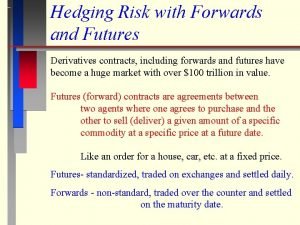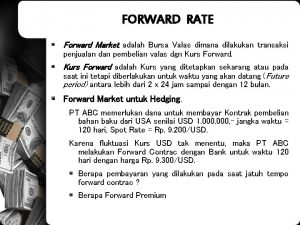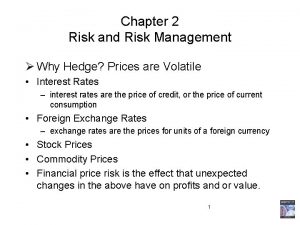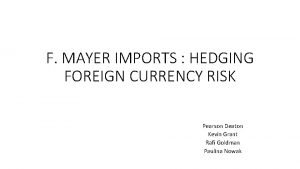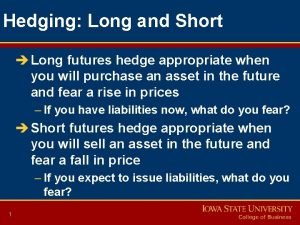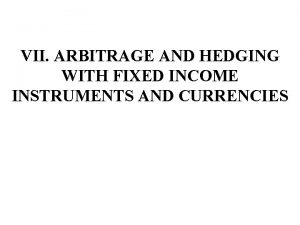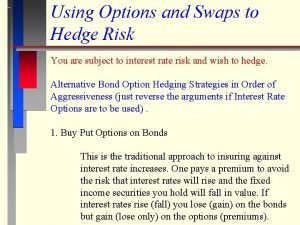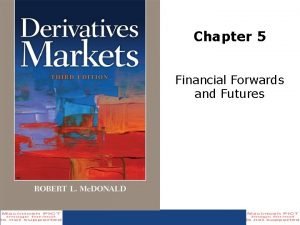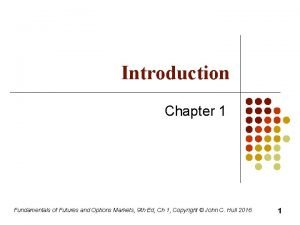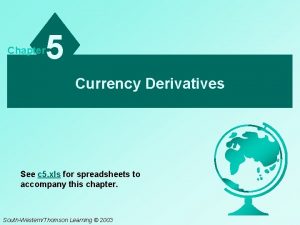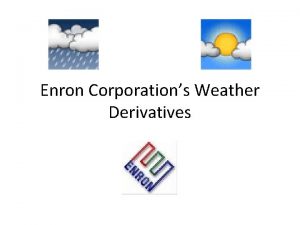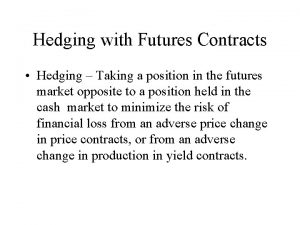Chapter 11 Forward and Futures Hedging Spread and
























































- Slides: 56

Chapter 11: Forward and Futures Hedging, Spread, and Target Strategies The beauty of finance and speculation was that they could be different things to different men. To some: poetry or high drama; to others, physics, scientific and immutable; to still others, politics or philosophy. And to still others, war. Michael M. Thomas Hanover Place, 1990, p. 37 Chance/Brooks An Introduction to Derivatives and Risk Management, 9 th ed. Ch. 11: 1 © 2010 Cengage Learning. All Rights Reserved. May not be scanned, copied or duplicated, or posted to a publicly accessible website, in whole or in part.

Important Concepts in Chapter 11 n n n Why firms hedge Hedging concepts Factors involved when constructing a hedge Hedge ratios Examples of foreign currency hedges, intermediate- and long-term interest rate hedges, and stock index futures hedges Examples of spread and target strategies Chance/Brooks An Introduction to Derivatives and Risk Management, 9 th ed. Ch. 11: 2 © 2010 Cengage Learning. All Rights Reserved. May not be scanned, copied or duplicated, or posted to a publicly accessible website, in whole or in part.

Why Hedge? n n The value of the firm may not be independent of financial decisions because u Shareholders might be unaware of the firm’s risks. u Shareholders might not be able to identify the correct number of futures contracts necessary to hedge. u Shareholders might have higher transaction costs of hedging than the firm. u There may be tax advantages to a firm hedging. u Hedging reduces bankruptcy costs. Managers may be reducing their own risk. Hedging may send a positive signal to creditors. Dealers hedge their market-making activities in derivatives. Chance/Brooks An Introduction to Derivatives and Risk Management, 9 th ed. Ch. 11: 3 © 2010 Cengage Learning. All Rights Reserved. May not be scanned, copied or duplicated, or posted to a publicly accessible website, in whole or in part.

Why Hedge? (continued) n Reasons not to hedge u Hedging can give a misleading impression of the amount of risk reduced u Hedging eliminates the opportunity to take advantage of favorable market conditions u There is no such thing as a hedge. Any hedge is an act of taking a position that an adverse market movement will occur. This, itself, is a form of speculation. Chance/Brooks An Introduction to Derivatives and Risk Management, 9 th ed. Ch. 11: 4 © 2010 Cengage Learning. All Rights Reserved. May not be scanned, copied or duplicated, or posted to a publicly accessible website, in whole or in part.

Hedging Concepts n Short Hedge and Long Hedge u Short (long) hedge implies a short (long) position in futures u Short hedges can occur because the hedger owns an asset and plans to sell it later. u Long hedges can occur because the hedger plans to purchase an asset later. u An anticipatory hedge is a hedge of a transaction that is expected to occur in the future. u See Table 11. 1 for hedging situations. Chance/Brooks An Introduction to Derivatives and Risk Management, 9 th ed. Ch. 11: 5 © 2010 Cengage Learning. All Rights Reserved. May not be scanned, copied or duplicated, or posted to a publicly accessible website, in whole or in part.

Hedging Concepts (continued) n The Basis u Basis = spot price - futures price. u Hedging and the Basis F P (short hedge) = ST - S 0 (from spot market) - (f. T - f 0) (from futures market) F P (long hedge) = -ST + S 0 (from spot market) + (f. T - f 0) (from futures market) F If hedge is closed prior to expiration, P (short hedge) = St - S 0 - (ft - f 0) F If hedge is held to expiration, St = ST = ft. Chance/Brooks An Introduction to Derivatives and Risk Management, 9 th ed. Ch. 11: 6 © 2010 Cengage Learning. All Rights Reserved. May not be scanned, copied or duplicated, or posted to a publicly accessible website, in whole or in part.

Hedging Concepts (continued) n The Basis (continued) u Hedging and the Basis (continued) F Example: Buy asset for $100, sell futures for $103. Hold until expiration. Sell asset for $97, close futures at $97. Or deliver asset and receive $103. Make $3 for sure. u Basis definition F initial basis: b 0 = S 0 - f 0 F basis at time t: bt = St - ft F basis at expiration: b. T = ST - f. T = 0 u For a position closed at t: F P (short hedge) = St - ft - (S 0 - f 0) = -b 0 + bt Chance/Brooks An Introduction to Derivatives and Risk Management, 9 th ed. Ch. 11: 7 © 2010 Cengage Learning. All Rights Reserved. May not be scanned, copied or duplicated, or posted to a publicly accessible website, in whole or in part.

Hedging Concepts (continued) n The Basis (continued) u This is the change in the basis and illustrates the principle of basis risk. u Hedging attempts to lock in the future price of an asset today, which will be f 0 + (St - ft). u A perfect hedge is practically non-existent. u Short hedges benefit from a strengthening basis. u All of this reverses for a long hedge. u See Table 11. 2 for hedging profitability and the basis. Chance/Brooks An Introduction to Derivatives and Risk Management, 9 th ed. Ch. 11: 8 © 2010 Cengage Learning. All Rights Reserved. May not be scanned, copied or duplicated, or posted to a publicly accessible website, in whole or in part.

Hedging Concepts (continued) n The Basis (continued) u Example: March 30. Spot gold $1, 387. 15. June futures $1, 388. 60. Buy spot, sell futures. Note: b 0 = 1, 387. 15 − 1, 388. 60 = − 1. 45. If held to expiration, profit should be change in basis or 1. 45. F At expiration, let ST = $1, 408. 50. Sell gold in spot for $1, 408. 50, a profit of 21. 35. Buy back futures at $1, 408. 50, a profit of − 19. 90. Net gain =1. 45 or $145 on 100 oz. of gold. Chance/Brooks An Introduction to Derivatives and Risk Management, 9 th ed. Ch. 11: 9 © 2010 Cengage Learning. All Rights Reserved. May not be scanned, copied or duplicated, or posted to a publicly accessible website, in whole or in part.

Hedging Concepts (continued) n The Basis (continued) u Example: (continued) F Instead, close out prior to expiration when St = $1, 377. 52 and ft = $1, 378. 63. F Profit on spot = − 9. 63. Profit on futures = 9. 97. F Net gain = 0. 34 or $34 on 100 oz. F Note that change in basis was bt − b 0 or − 1. 11 − (− 1. 45) = 0. 34. u Behavior of the basis, see Figure 11. 1. u In forward markets, the hedge is customized so there is no basis risk. Chance/Brooks An Introduction to Derivatives and Risk Management, 9 th ed. Ch. 11: 10 © 2010 Cengage Learning. All Rights Reserved. May not be scanned, copied or duplicated, or posted to a publicly accessible website, in whole or in part.

Hedging Concepts (continued) n Some Risks of Hedging u cross hedging u spot and futures prices occasionally move opposite u quantity risk Chance/Brooks An Introduction to Derivatives and Risk Management, 9 th ed. Ch. 11: 11 © 2010 Cengage Learning. All Rights Reserved. May not be scanned, copied or duplicated, or posted to a publicly accessible website, in whole or in part.

Hedging Concepts (continued) n Contract Choice u Which futures underlying asset? F High correlation with spot F Favorably priced u Which expiration? F The futures with maturity closest to but after the hedge termination date subject to the suggestion not to be in a contract in its expiration month F See Table 11. 3 for example of recommended contracts for T-bond hedge F Concept of rolling the hedge forward Chance/Brooks An Introduction to Derivatives and Risk Management, 9 th ed. Ch. 11: 12 © 2010 Cengage Learning. All Rights Reserved. May not be scanned, copied or duplicated, or posted to a publicly accessible website, in whole or in part.

Hedging Concepts (continued) n Contract Choice (continued) u Long or short? F A critical decision! No room for mistakes. F Three methods to answer the question. See Table 11. 4. • worst case scenario method • current spot position method • anticipated future spot transaction method Chance/Brooks An Introduction to Derivatives and Risk Management, 9 th ed. Ch. 11: 13 © 2010 Cengage Learning. All Rights Reserved. May not be scanned, copied or duplicated, or posted to a publicly accessible website, in whole or in part.

Hedging Concepts (continued) n Margin Requirements and Marking to Market u low margin requirements on futures, but u cash will be required for margin calls Chance/Brooks An Introduction to Derivatives and Risk Management, 9 th ed. Ch. 11: 14 © 2010 Cengage Learning. All Rights Reserved. May not be scanned, copied or duplicated, or posted to a publicly accessible website, in whole or in part.

Determination of the Hedge Ratio n Hedge ratio: The number of futures contracts to hedge a particular exposure u Naïve hedge ratio u Appropriate hedge ratio should be F Nf = − S/ f − F Note that this ratio must be estimated. Chance/Brooks An Introduction to Derivatives and Risk Management, 9 th ed. Ch. 11: 15 © 2010 Cengage Learning. All Rights Reserved. May not be scanned, copied or duplicated, or posted to a publicly accessible website, in whole or in part.

Determination of the Hedge Ratio (continued) n Minimum Variance Hedge Ratio u Profit from short hedge: F P = S + f. Nf u Variance of profit from short hedge: F s. P 2 = s S 2 + s f 2 Nf 2 + 2 s S f. Nf u The optimal (variance minimizing) hedge ratio is F N f = − s S f/ s f 2 F This is the beta from a regression of spot price change on futures price change. Chance/Brooks An Introduction to Derivatives and Risk Management, 9 th ed. Ch. 11: 16 © 2010 Cengage Learning. All Rights Reserved. May not be scanned, copied or duplicated, or posted to a publicly accessible website, in whole or in part.

Determination of the Hedge Ratio (continued) n Minimum Variance Hedge Ratio (continued) u Hedging effectiveness is F e* = (risk of unhedged position − risk of hedged position)/risk of unhedged position F This is coefficient of determination from regression. Chance/Brooks An Introduction to Derivatives and Risk Management, 9 th ed. Ch. 11: 17 © 2010 Cengage Learning. All Rights Reserved. May not be scanned, copied or duplicated, or posted to a publicly accessible website, in whole or in part.

Determination of the Hedge Ratio (continued) n Price Sensitivity Hedge Ratio u This applies to hedges of interest sensitive securities. u First we introduce the concept of duration. We start with a bond priced at B: F where CPt is the cash payment at time t and y. B is the yield, or discount rate. Chance/Brooks An Introduction to Derivatives and Risk Management, 9 th ed. Ch. 11: 18 © 2010 Cengage Learning. All Rights Reserved. May not be scanned, copied or duplicated, or posted to a publicly accessible website, in whole or in part.

Determination of the Hedge Ratio (continued) n Price Sensitivity Hedge Ratio (continuation) u An approximation to the change in price for a yield change is u u u with DURB being the bond’s duration, which is a weighted-average of the times to each cash payment date on the bond, and represents the change in the bond price or yield. Duration has many weaknesses but is widely used as a measure of the sensitivity of a bond’s price to its yield. Modified duration (MD) measures the bond percentage price change for a given change in yield. Chance/Brooks An Introduction to Derivatives and Risk Management, 9 th ed. Ch. 11: 19 © 2010 Cengage Learning. All Rights Reserved. May not be scanned, copied or duplicated, or posted to a publicly accessible website, in whole or in part.

Determination of the Hedge Ratio (continued) n Price Sensitivity Hedge Ratio (continuation) u The hedge ratio is as follows: u Where MDB » −( B/B) / y. B and MDf » −( f/f) / yf u Note the concepts of implied yield and implied duration of a futures. Also, technically, the hedge ratio will change continuously like an option’s delta and, like delta, it will not capture the risk of large moves. Chance/Brooks An Introduction to Derivatives and Risk Management, 9 th ed. Ch. 11: 20 © 2010 Cengage Learning. All Rights Reserved. May not be scanned, copied or duplicated, or posted to a publicly accessible website, in whole or in part.

Determination of the Hedge Ratio (continued) n Price Sensitivity Hedge Ratio (continued) u Alternatively, F Nf = −(Yield beta)PVBPB/PVBPf • where Yield beta is the beta from a regression of spot bond yield on futures yield and • PVBPB, PVBPf is the present value of a basis point change in the bond and futures prices. Chance/Brooks An Introduction to Derivatives and Risk Management, 9 th ed. Ch. 11: 21 © 2010 Cengage Learning. All Rights Reserved. May not be scanned, copied or duplicated, or posted to a publicly accessible website, in whole or in part.

Determination of the Hedge Ratio (continued) n Stock Index Futures Hedging u Appropriate hedge ratio is F Nf = −(b −( S/bf)(S/f) F where b. S is the beta from the CAPM and bf is the beta of the futures, often assumed to be 1. Chance/Brooks An Introduction to Derivatives and Risk Management, 9 th ed. Ch. 11: 22 © 2010 Cengage Learning. All Rights Reserved. May not be scanned, copied or duplicated, or posted to a publicly accessible website, in whole or in part.

Hedging Strategies n n Long Hedge With Foreign Currency Futures u American firm planning to buy foreign inventory and will pay in foreign currency. u See Table 11. 5. Short Hedge With Foreign Currency Forwards u British subsidiary of American firm will convert pounds to dollars. u See Table 11. 6. Chance/Brooks An Introduction to Derivatives and Risk Management, 9 th ed. Ch. 11: 23 © 2010 Cengage Learning. All Rights Reserved. May not be scanned, copied or duplicated, or posted to a publicly accessible website, in whole or in part.

Hedging Strategies (continued) n Intermediate and Long-Term Interest Rate Hedges u First let us look at the CBOT T-note and bond contracts F T-bonds: must be a T-bond with at least 15 years to maturity or first call date F T-note: three contracts (2 -, 5 -, and 10 -year) F A bond of any coupon can be delivered but the standard is a 6% coupon. Adjustments, explained in Chapter 10, are made to reflect other coupons. F Price is quoted in units and 32 nds, relative to $100 par, e. g. , 93 14/32 is $93. 4375. F Contract size is $100, 000 face value so price is $93, 437. 50 Chance/Brooks An Introduction to Derivatives and Risk Management, 9 th ed. Ch. 11: 24 © 2010 Cengage Learning. All Rights Reserved. May not be scanned, copied or duplicated, or posted to a publicly accessible website, in whole or in part.

Hedging Strategies (continued) n Intermediate and Long-Term Interest Rate Hedges (continued) u Hedging a Long Position in a Government Bond F See Table 11. 7 for example. u Anticipatory Hedge of a Future Purchase of a Treasury Note F See Table 11. 8 for example. u Hedging a Corporate Bond Issue F See Table 11. 9 for example. Chance/Brooks An Introduction to Derivatives and Risk Management, 9 th ed. Ch. 11: 25 © 2010 Cengage Learning. All Rights Reserved. May not be scanned, copied or duplicated, or posted to a publicly accessible website, in whole or in part.

Hedging Strategies (continued) n Stock Market Hedges u First look at the contracts F We primarily shall use the S&P 500 futures. Its price is determined by multiplying the quoted price by $250, e. g. , if the futures is at 1300, the price is 1300($250) = $325, 000 u Stock Portfolio Hedge F See Table 11. 10 for example. u Anticipatory Hedge of a Takeover F See Table 11. 11 for example. Chance/Brooks An Introduction to Derivatives and Risk Management, 9 th ed. Ch. 11: 26 © 2010 Cengage Learning. All Rights Reserved. May not be scanned, copied or duplicated, or posted to a publicly accessible website, in whole or in part.

Spread Strategies n n n Intramarket Spreads u Based on changes in the difference in carry costs u See Figure 11. 2 for illustration. Treasury Bond Futures Spreads u See Figure 11. 3 and Figure 11. 4 for illustration the relationship between changes in spreads and interest rates. u See Table 11. 12 for calculation of Tbond futures spread profits. See Figure 11. 5 for illustration of stock index spreads Chance/Brooks An Introduction to Derivatives and Risk Management, 9 th ed. Ch. 11: 27 © 2010 Cengage Learning. All Rights Reserved. May not be scanned, copied or duplicated, or posted to a publicly accessible website, in whole or in part.

Intermarket Spread Strategies n n Intermarket spread strategies involve two futures contracts on different underlying instruments Intermarket spread strategies tend to be more risky than intramarket spreads because there is both the change in spreads and the change in underlying instruments NOB denotes over bonds Intermarket spread strategies could also involve various equity markets Chance/Brooks An Introduction to Derivatives and Risk Management, 9 th ed. Ch. 11: 28 © 2010 Cengage Learning. All Rights Reserved. May not be scanned, copied or duplicated, or posted to a publicly accessible website, in whole or in part.

Target Strategies: Bonds n Target Duration with Bond Futures u Number of futures needed to change modified duration u Goal is to move the modified duration from its current value to a new target value u See Table 11. 13 for illustration. Chance/Brooks An Introduction to Derivatives and Risk Management, 9 th ed. Ch. 11: 29 © 2010 Cengage Learning. All Rights Reserved. May not be scanned, copied or duplicated, or posted to a publicly accessible website, in whole or in part.

Target Strategies: Equities n Alpha Capture u Number of futures to hedge systematic risk u Goal is to move the eliminate systematic risk u See Table 11. 14 for illustration. n Target Beta (see Table 11. 15 for illustration. ) Chance/Brooks An Introduction to Derivatives and Risk Management, 9 th ed. Ch. 11: 30 © 2010 Cengage Learning. All Rights Reserved. May not be scanned, copied or duplicated, or posted to a publicly accessible website, in whole or in part.

Target Strategies: Equities (continued) n Tactical Asset Allocation u Strategic asset allocation – long run target weights for each asset class u Tactical asset allocation – short run deviations in weights for each asset class u See Table 11. 16 for illustration. Chance/Brooks An Introduction to Derivatives and Risk Management, 9 th ed. Ch. 11: 31 © 2010 Cengage Learning. All Rights Reserved. May not be scanned, copied or duplicated, or posted to a publicly accessible website, in whole or in part.

Summary n Table 11. 17 recaps the types of hedge situations, the nature of the risk and how to hedge the risk Chance/Brooks An Introduction to Derivatives and Risk Management, 9 th ed. Ch. 11: 32 © 2010 Cengage Learning. All Rights Reserved. May not be scanned, copied or duplicated, or posted to a publicly accessible website, in whole or in part.

Appendix 11: Taxation of Hedging n n Hedges used by businesses to protect inventory and in standard business transactions are taxed as ordinary income. Transactions must be shown to be legitimate hedges and not just speculation outside of the norm of ordinary business activities. This is called the business motive test. Chance/Brooks An Introduction to Derivatives and Risk Management, 9 th ed. Ch. 11: 33 © 2010 Cengage Learning. All Rights Reserved. May not be scanned, copied or duplicated, or posted to a publicly accessible website, in whole or in part.

(Return to text slide) Chance/Brooks An Introduction to Derivatives and Risk Management, 9 th ed. Ch. 11: 34 © 2010 Cengage Learning. All Rights Reserved. May not be scanned, copied or duplicated, or posted to a publicly accessible website, in whole or in part.

(Return to text slide) Chance/Brooks An Introduction to Derivatives and Risk Management, 9 th ed. Ch. 11: 35 © 2010 Cengage Learning. All Rights Reserved. May not be scanned, copied or duplicated, or posted to a publicly accessible website, in whole or in part.

(Return to text slide) Chance/Brooks An Introduction to Derivatives and Risk Management, 9 th ed. Ch. 11: 36 © 2010 Cengage Learning. All Rights Reserved. May not be scanned, copied or duplicated, or posted to a publicly accessible website, in whole or in part.

(Return to text slide) Chance/Brooks An Introduction to Derivatives and Risk Management, 9 th ed. Ch. 11: 37 © 2010 Cengage Learning. All Rights Reserved. May not be scanned, copied or duplicated, or posted to a publicly accessible website, in whole or in part.

(Return to text slide) Chance/Brooks An Introduction to Derivatives and Risk Management, 9 th ed. Ch. 11: 38 © 2010 Cengage Learning. All Rights Reserved. May not be scanned, copied or duplicated, or posted to a publicly accessible website, in whole or in part.

(Return to text slide) Chance/Brooks An Introduction to Derivatives and Risk Management, 9 th ed. Ch. 11: 39 © 2010 Cengage Learning. All Rights Reserved. May not be scanned, copied or duplicated, or posted to a publicly accessible website, in whole or in part.

(Return to text slide) Chance/Brooks An Introduction to Derivatives and Risk Management, 9 th ed. Ch. 11: 40 © 2010 Cengage Learning. All Rights Reserved. May not be scanned, copied or duplicated, or posted to a publicly accessible website, in whole or in part.

(Return to text slide) Chance/Brooks An Introduction to Derivatives and Risk Management, 9 th ed. Ch. 11: 41 © 2010 Cengage Learning. All Rights Reserved. May not be scanned, copied or duplicated, or posted to a publicly accessible website, in whole or in part.

(Return to text slide) Chance/Brooks An Introduction to Derivatives and Risk Management, 9 th ed. Ch. 11: 42 © 2010 Cengage Learning. All Rights Reserved. May not be scanned, copied or duplicated, or posted to a publicly accessible website, in whole or in part.

(Return to text slide) Chance/Brooks An Introduction to Derivatives and Risk Management, 9 th ed. Ch. 11: 43 © 2010 Cengage Learning. All Rights Reserved. May not be scanned, copied or duplicated, or posted to a publicly accessible website, in whole or in part.

(Return to text slide) Chance/Brooks An Introduction to Derivatives and Risk Management, 9 th ed. Ch. 11: 44 © 2010 Cengage Learning. All Rights Reserved. May not be scanned, copied or duplicated, or posted to a publicly accessible website, in whole or in part.

(Return to text slide) Chance/Brooks An Introduction to Derivatives and Risk Management, 9 th ed. Ch. 11: 45 © 2010 Cengage Learning. All Rights Reserved. May not be scanned, copied or duplicated, or posted to a publicly accessible website, in whole or in part.

(Return to text slide) Chance/Brooks An Introduction to Derivatives and Risk Management, 9 th ed. Ch. 11: 46 © 2010 Cengage Learning. All Rights Reserved. May not be scanned, copied or duplicated, or posted to a publicly accessible website, in whole or in part.

(Return to text slide) Chance/Brooks An Introduction to Derivatives and Risk Management, 9 th ed. Ch. 11: 47 © 2010 Cengage Learning. All Rights Reserved. May not be scanned, copied or duplicated, or posted to a publicly accessible website, in whole or in part.

(Return to text slide) Chance/Brooks An Introduction to Derivatives and Risk Management, 9 th ed. Ch. 11: 48 © 2010 Cengage Learning. All Rights Reserved. May not be scanned, copied or duplicated, or posted to a publicly accessible website, in whole or in part.

(Return to text slide) Chance/Brooks An Introduction to Derivatives and Risk Management, 9 th ed. Ch. 11: 49 © 2010 Cengage Learning. All Rights Reserved. May not be scanned, copied or duplicated, or posted to a publicly accessible website, in whole or in part.

(Return to text slide) Chance/Brooks An Introduction to Derivatives and Risk Management, 9 th ed. Ch. 11: 50 © 2010 Cengage Learning. All Rights Reserved. May not be scanned, copied or duplicated, or posted to a publicly accessible website, in whole or in part.

(Return to text slide) Chance/Brooks An Introduction to Derivatives and Risk Management, 9 th ed. Ch. 11: 51 © 2010 Cengage Learning. All Rights Reserved. May not be scanned, copied or duplicated, or posted to a publicly accessible website, in whole or in part.

(Return to text slide) Chance/Brooks An Introduction to Derivatives and Risk Management, 9 th ed. Ch. 11: 52 © 2010 Cengage Learning. All Rights Reserved. May not be scanned, copied or duplicated, or posted to a publicly accessible website, in whole or in part.

(Return to text slide) Chance/Brooks An Introduction to Derivatives and Risk Management, 9 th ed. Ch. 11: 53 © 2010 Cengage Learning. All Rights Reserved. May not be scanned, copied or duplicated, or posted to a publicly accessible website, in whole or in part.

(To Continue) Chance/Brooks (Return to text slide 31) An Introduction to Derivatives and Risk Management, 9 th ed. Ch. 11: 54 © 2010 Cengage Learning. All Rights Reserved. May not be scanned, copied or duplicated, or posted to a publicly accessible website, in whole or in part.

(To Previous Slide) (Return to text slide 31) Chance/Brooks An Introduction to Derivatives and Risk Management, 9 th ed. Ch. 11: 55 © 2010 Cengage Learning. All Rights Reserved. May not be scanned, copied or duplicated, or posted to a publicly accessible website, in whole or in part.

(Return to text slide) Chance/Brooks An Introduction to Derivatives and Risk Management, 9 th ed. Ch. 11: 56 © 2010 Cengage Learning. All Rights Reserved. May not be scanned, copied or duplicated, or posted to a publicly accessible website, in whole or in part.
 Tailing the hedge
Tailing the hedge Hedging strategies using futures and options
Hedging strategies using futures and options Hedging strategies using futures
Hedging strategies using futures Hedging interest rate risk with futures
Hedging interest rate risk with futures Hedge ratio
Hedge ratio Fed tapering
Fed tapering Forward rate dan forward market adalah
Forward rate dan forward market adalah Forward market adalah
Forward market adalah Hedging and boosting
Hedging and boosting Hedged item and hedging instrument examples
Hedged item and hedging instrument examples Hedging receivables and payables
Hedging receivables and payables Hedging in academic writing exercises
Hedging in academic writing exercises Greek vega
Greek vega Features of academic writing exercises with answers
Features of academic writing exercises with answers Transfer risiko
Transfer risiko Hedging in writing
Hedging in writing Hedging adalah
Hedging adalah What is cautious language
What is cautious language Hedging manages risk that are manageable
Hedging manages risk that are manageable Main objective of hedging
Main objective of hedging F. mayer imports: hedging foreign currency risk
F. mayer imports: hedging foreign currency risk Oil hedging definition
Oil hedging definition Cattle hedging strategies
Cattle hedging strategies Contoh instrumen derivatif
Contoh instrumen derivatif Optimal hedge ratio
Optimal hedge ratio Hedging approach of working capital
Hedging approach of working capital Fixed income hedging
Fixed income hedging Hedging credit risk with options
Hedging credit risk with options Hedging adalah
Hedging adalah Mortgage hedging 101
Mortgage hedging 101 Static hedging of exotic options
Static hedging of exotic options Chapter 16 lesson 1 the protestant reformation
Chapter 16 lesson 1 the protestant reformation Options futures and risk management
Options futures and risk management Prepaid forward contract formula
Prepaid forward contract formula Options, futures, and other derivatives
Options, futures, and other derivatives Fundamentals of futures and options markets
Fundamentals of futures and options markets Traders in financial futures
Traders in financial futures Currency futures and options
Currency futures and options Pt.member of jakarta
Pt.member of jakarta Futures pricing
Futures pricing Cheapest to deliver
Cheapest to deliver Euro btp future
Euro btp future Future contracts
Future contracts Interest rate futures
Interest rate futures Currency futures
Currency futures Bright futures scholarship
Bright futures scholarship Bright futures screening guidelines
Bright futures screening guidelines Tobacco free futures
Tobacco free futures Hesa data futures
Hesa data futures Euro stoxx 50 index dividend futures
Euro stoxx 50 index dividend futures A pedagogy of multiliteracies: designing social futures
A pedagogy of multiliteracies: designing social futures Currency futures contracts sold on an exchange
Currency futures contracts sold on an exchange Language futures
Language futures Fair value of futures contract
Fair value of futures contract Esf futures
Esf futures Enron weather futures
Enron weather futures Stoxx blue chip
Stoxx blue chip





